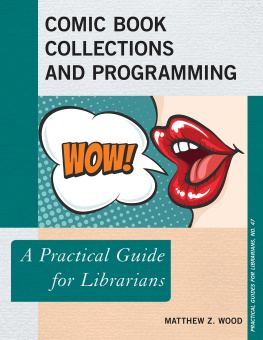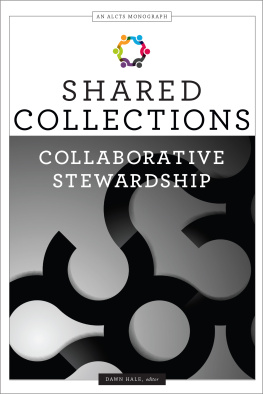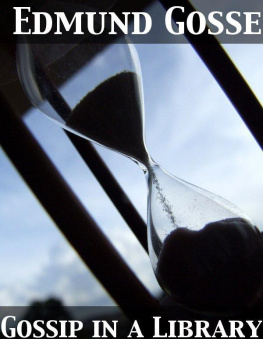Thanks to my family, friends, and colleagues who supported me as I wrote this book. I could not have finished this book without you. A special thank-you to Travis Schulz. Your love and support made all the difference. You kept me going.
I would like to acknowledge the International Federation of Library Associations and Institutions (IFLA). I used two images from their publications in . I contacted them for permission but never received a response.
Gretchen L. Hoffman is an associate professor of library and information studies at Texas Womans University, in Denton, Texas. Her research and teaching interests center on the organization of information, specifically library cataloging. She focuses on issues surrounding the work of catalogers, the cataloging process, and the administration of cataloging departments, with the broader goal of understanding how work is performed in libraries. She also is interested in the teaching and learning of cataloging. She has published several articles and book chapters and has given numerous presentations in these areas.
Hoffman has had an interest in organizing library collections since 1992, when she was a student worker at her undergraduate universitys library, focusing on serials check-in and binding. She continued to work in academic libraries in paraprofessional positions in serials acquisitions and serials cataloging, eventually working as a professional cataloger in both serials and monographs. She especially enjoyed cataloging serials, music scores, and audio recordings. She enjoyed organizing library collections so much that she earned her PhD and started teaching students how to organize library collections. She wants students to understand that organizing library collections is essential to helping users find and use library materials, and that although the work is challenging, it can be a lot of fun, too. She has been teaching in this area since 2004, and has taught fully online courses at Texas Womans University since 2007.
Hoffman earned a PhD in library and information science from Emporia State University in 2008, a master of library science from Emporia State University in 2000, and a bachelor of arts in music from the University of Nevada, Reno, in 1995. She has won several awards for her teaching. In 2011 she was given the Outstanding Faculty Award for Teacher in Distance Education from TWUs College of Professional Education, and in 2013 she was awarded the TWU Faculty Award for Distinction in Distance Education. In 2018 she was given the Award for Outstanding Academic Mentor/Advisor from TWUs College of Professional Education.
A native of northwestern Minnesota living in Texas, she loves the Texas winters but misses the Minnesota summers.
AACR: Anglo-American Cataloguing Rules
AACR1: Anglo-American Cataloguing Rules, First Edition
AACR2: Anglo-American Cataloguing Rules, Second Edition
AAT: Art & Architecture Thesaurus
ALA: American Library Association
ALCTS: Association for Library Collections & Technical Services (ALA)
BIBCO: Monographic Bibliographic Record Cooperative Program
BIBFRAME: Bibliographic Framework Initiative
BISAC: Book Industry Standards and Communications
CaMMS: Cataloging and Metadata Management Section (ALA ALCTS)
CCO: Cataloging Cultural Objects
CONSER: Cooperative Online Serials Program
CSM: Classification and Shelflisting Manual (LCC)
CSS: Cascading Style Sheets
DACS: Describing Archives: A Content Standard
DC: Dublin Core
DCMI: Dublin Core Metadata Initiative
DDC: Dewey Decimal Classification
EAD: Encoded Archival Description
FAST: Faceted Application of Subject Terminology
FDLP: Federal Depository Library Program
FRAD: Functional Requirements for Authority Data
FRBR: Functional Requirements for Bibliographic Records
FRSAD: Functional Requirements for Subject Authority Data
GSAFD: Guidelines on Subject Access to Individual Works of Fiction, Drama, Etc.
HTML: Hypertext Markup Language
HTTP: Hypertext Transfer Protocol
IFLA: International Federation of Library Associations and Institutions
IRI: Internationalized Resource Identifier
ISBD: International Standard Bibliographic Description
ISBN: International Standard Bibliographic Number
ISNI: International Standard Name Identifier
ISO: International Organization for Standardization
ISSN: International Standard Serial Number
LC: Library of Congress
LC-PCC PS: Library of Congress-Program for Cooperative Cataloging Policy Statements
LCC: Library of Congress Classification
LCCN: Library of Congress Control Number
LCDGT: Library of Congress Demographic Group Terms
LCGFT: Library of Congress Genre/Form Terms for Library and Archival Materials
LCMPT: Library of Congress Medium of Performance Thesaurus for Music
LCNAF: Library of Congress National Authority File
LCSH: Library of Congress Subject Headings
LITA: Library and Information Technology Association
LRM: IFLA Library Reference Model
MADS: Metadata Authority Description Schema
MARC: Machine-Readable Cataloging
MeSH: Medical Subject Headings
MODS: Metadata Object Description Schema
NACO: Name Authority Cooperative Program
NAF: National Authority File (Library of Congress)
NASIG: North American Serials Interest Group
NISO: National Information Standards Organization
NLM: National Library of Medicine
OCLC: Company name. Formerly called: Online Computer Library Center
OLAC: Online Audiovisual Catalogers
OPAC: Online Public Access Catalog
PCC: Program for Cooperative Cataloging
RBMS: Rare Books and Manuscripts Section
RDA: Resource Description and Access
RDF: Resource Description Framework
SACO: Subject Authority Cooperative Program
SGML: Standard Generalized Markup Language
SHM: Subject Headings Manual (LCSH)
SSH: Sears List of Subject Headings
SuDocs: Superintendent of Documents Classification
TEI: Text Encoding Initiative
TGM: Thesaurus for Graphic Materials
URI: Uniform Resource Identifier
URL: Uniform Resource Locator
VIAF: Virtual International Authority File
VRA: Visual Resources Association
W3C: World Wide Web Consortium
WEMI: WorkExpressionManifestationItem (FRBR)
XML: Extensible Markup Language
To my parents, whom I lost far too soon.
Organization is infused into all aspects of our everyday lives. It helps us make sense of the world and function in the world. The purpose of organization is to create a functioning whole, a system whose various parts work together to meet certain goals. Organization is needed everywhere, and systems of organization are created to help us in various ways. A hospital is organized to facilitate the treatment of patients. A retail store is organized to facilitate purchases. A kitchen is organized to facilitate the preparation of food. Individuals and groups organize, too. A person may organize closets, photos, bookshelves, or files to quickly and easily find items. Workplaces organize documents and other items to facilitate work, to make money, and to follow government regulations.








